Plants
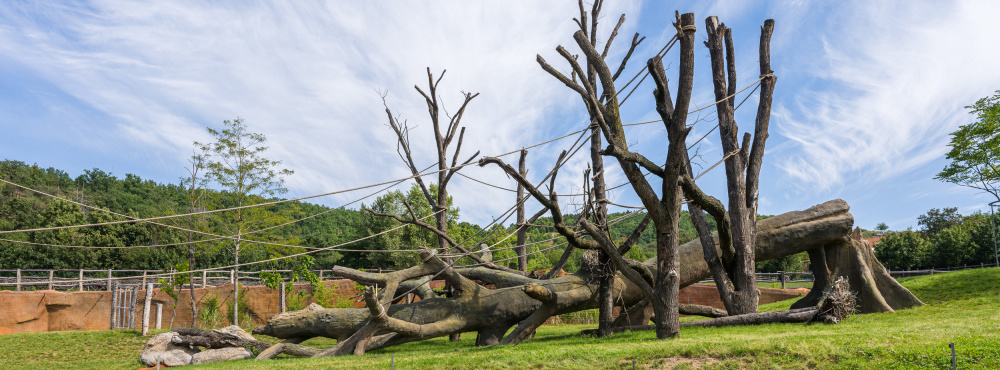
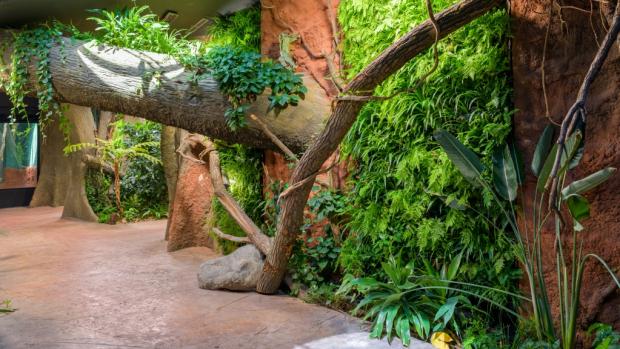 Fallen trees also contribute to the rainforest atmosphere. Photo: Petr Hamerník, Prague Zoo
Fallen trees also contribute to the rainforest atmosphere. Photo: Petr Hamerník, Prague Zoo
Plants inside the pavilion
The plants inside the pavilion fully represent those that grow in the geographical areas where gorillas occur in the wild and thus give the visitor a credible impression of the African equatorial forest.
In the visitor area, the trees are in fact faithful concrete imitations of the rainforest giants, with typical buttress and prop roots anchoring the tree’s huge mass in the moist rainforest soil.
Among the living trees, you can see the fiddle-leaf fig (Ficus lyrata), with its large, leathery, guitar-shaped leaves, and the African fig (Ficus cyathistipula), which has smaller, egg-shaped leaves. The fruits of both species resemble figs but are not used for human consumption. These woody plants follow a life strategy that begins in the canopy of another tree: from there, they send roots down to the ground, using the host tree’s trunk for support, and gradually wrap around it until they completely encase it. This is where the popular name “strangler fig” comes from. One curiosity from the animal kingdom is the feeding habits of gorillas, which eat the leaves of these trees, even though the plants secrete a poisonous white latex when injured as a defence against herbivores.
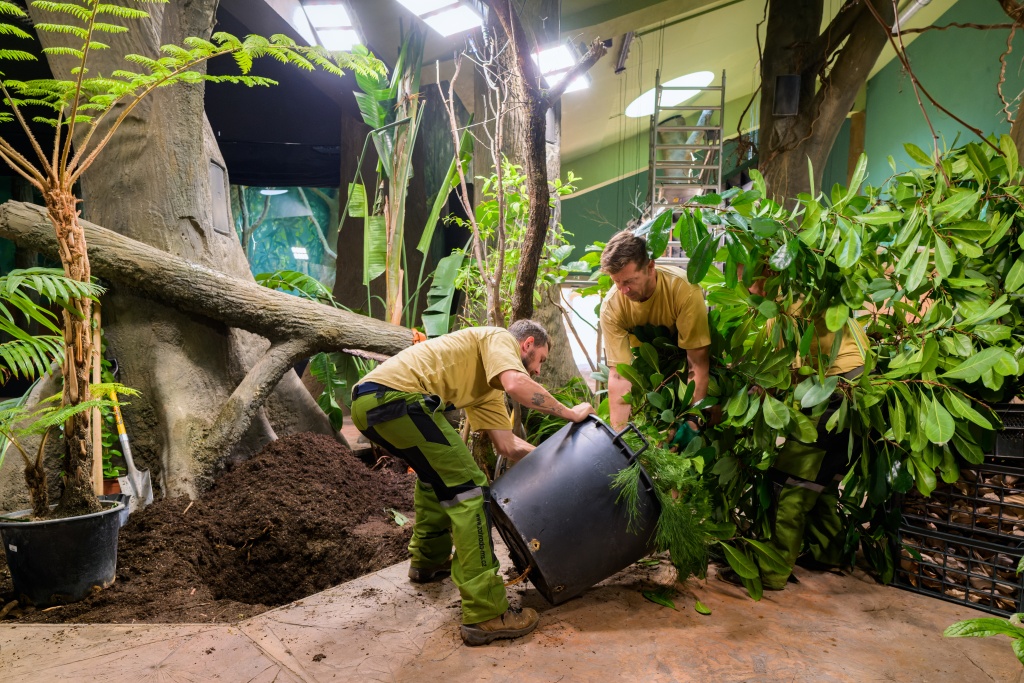
The gardeners planted dozens of mature African plants indoors. Photo: Petr Hamerník, Prague Zoo
The shrub layer is represented by many species. The most striking of these, the giant white bird of paradise (Strelitzia nicolai), catches the eye with its giant leaves resembling those of a banana plant, and growth more reminiscent of trees than herbs. Unlike the common bird of paradise (Strelitzia reginae), known in the florist’s trade for its bird-like orange flowers, it blooms white.
Another rather tree-like herb is the tree fern (Cyathea spp.), with a trunk more than a metre high. The final shrub we will mention is surely very familiar to you. The cornstalk (Dracaena deremensis) can often be found growing in the corners of our rooms. Surprisingly, it too originally comes from the tropical rainforests of Africa.
The lowest layer—the herbaceous undergrowth—is often intermingled with poisonous plants of the arum family, such as Nephthytis poissonii. Its arrowhead-shaped leaves are complemented by distinctive yellow-orange fruits for most of the year. The notorious touch-me-not (Impatiens balsaminea), commonly used in pots or annual beds, also originates from the dark undergrowth of the African rainforest.
The visual essence of the jungle lies not so much in the towering forest giants as in the impenetrable tangles of lianas. Perhaps the most interesting of these is an orchid that lends its flavour to all kinds of sweet pastries and other food products: vanilla. Indeed, vanilla pods—the fermented fruit of a climbing orchid—are also cultivated in Africa.
Frequent rainfall and stable temperatures make equatorial Africa an ideal environment for plant growth. Competition for such a desirable but overcrowded place has driven many plants up into the treetops to be closer to the sun. These are known as epiphytes. Ferns, in particular, have adapted to life without direct contact with the soil. Their leaves form a kind of funnel or cone that captures rainwater, organic debris from decomposing leaves, and the droppings of animals that have found a comfortable and safe home there. In the forks of the concrete imitations of giant tropical trees, you can see epiphytic ferns from the genera Platycerium (staghorn or elkhorn fern) and Drynaria (basket fern).
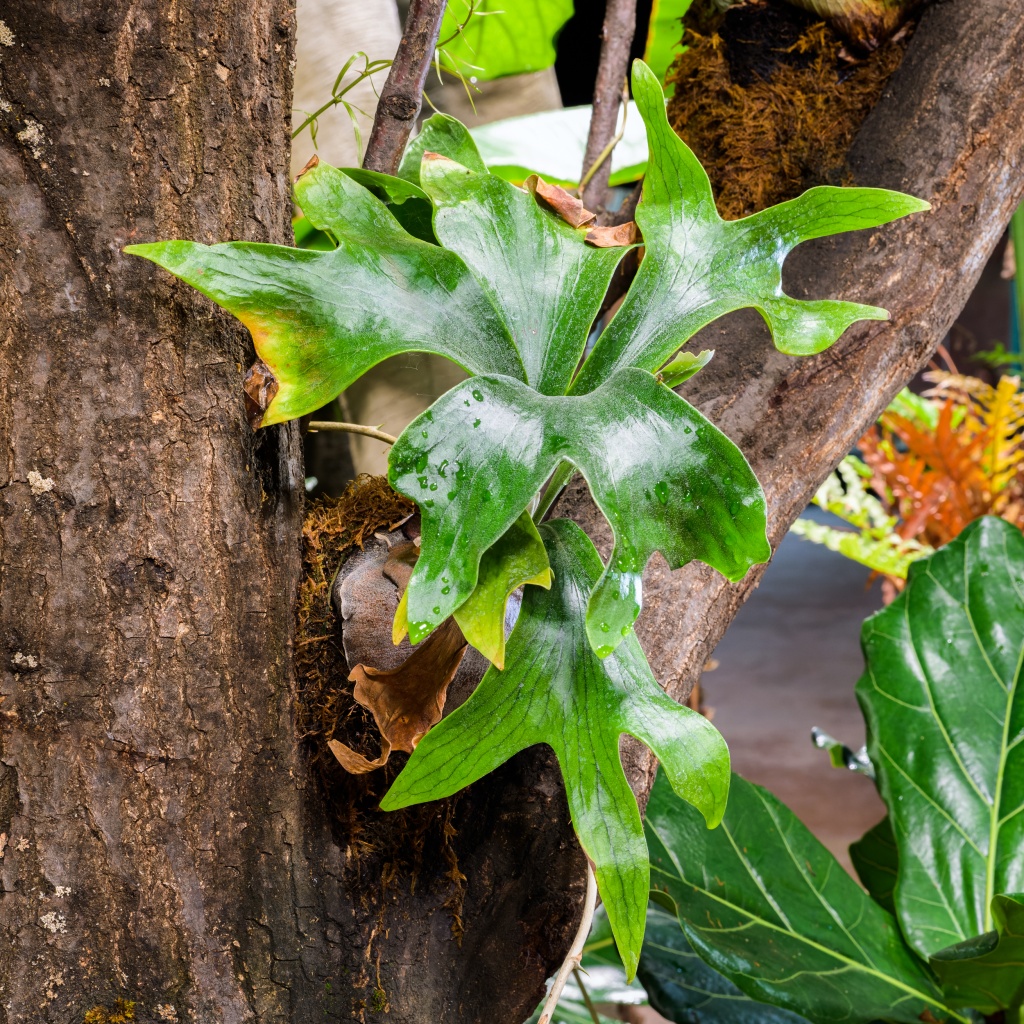
Epiphytic ferns grow directly on trees, without any contact with the soil. Photo: Petr Hamerník, Prague Zoo
The visitor trail leads not only past concrete imitations of rainforest giants but also along the bottom of a deep riverbed, beginning at a waterfall and continuing between furrowed walls covered with lush tropical vegetation full of ferns.
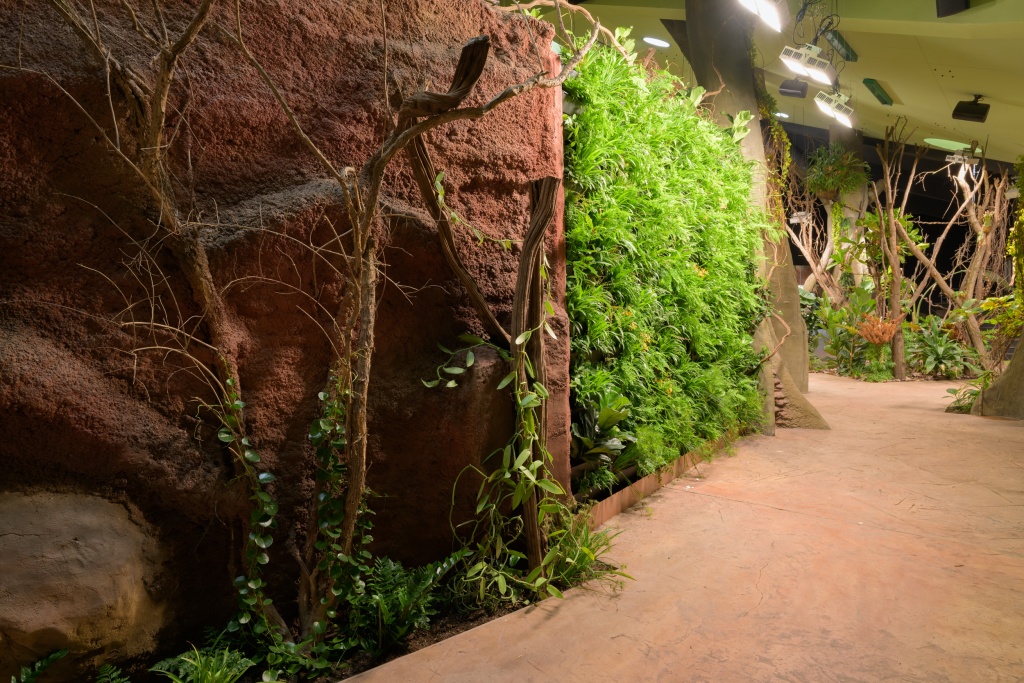
The pavilion also features green walls planted entirely with vegetation. Photo: Petr Hamerník, Prague Zoo
These living green walls are sustained by an ingenious cascading cell system. Drip irrigation feeds water through the 2,480 plastic cells, delivering a constant and precise supply—not just any water, however. Tropical plants are adapted to soft, mineral-poor rainwater, so we use reverse osmosis technology to remove most of the minerals from standard drinking water.
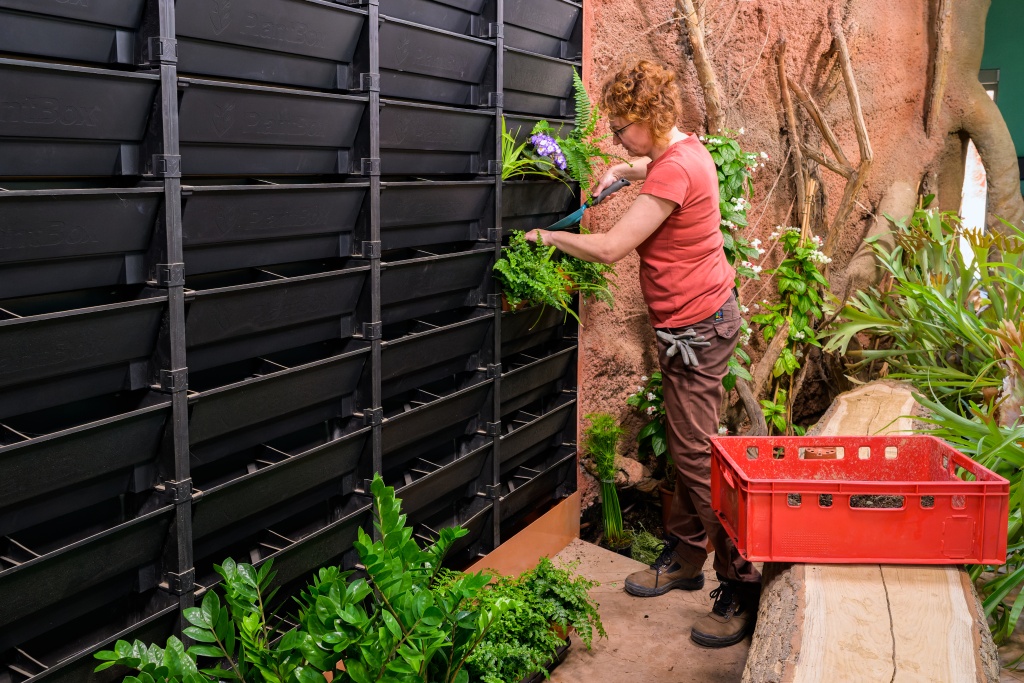
The green walls are brought to life by a cascading cell system made up of nearly two and a half thousand plastic cells. Photo: Petr Hamerník, Prague Zoo
Plants outside the pavilion
The irrigation of plants inside the pavilion requires a very complex system, as described above. But why not simply collect rainwater from the pavilion roofs? Green space was also needed there to sensitively integrate the pavilion into the surrounding landscape. This led to the creation of a semi-intensive green roof with a natural character—one of the largest green roofs in the country. The roof’s special composition, including its substrate, can retain most of the rainwater and gradually release it to the plants growing there. These plants consist of xerothermic and steppe communities of grasses and forbs, similar to those found in the nearby Vltava canyon and on the steppe meadows beneath the Sklenářka building. Already in the second year after its establishment, very rare invertebrate species were detected here. The vegetated roof of the Dja Reserve is therefore not only an aesthetic landscape-forming feature with a positive impact on the microclimate, but also serves as a centre of biodiversity.
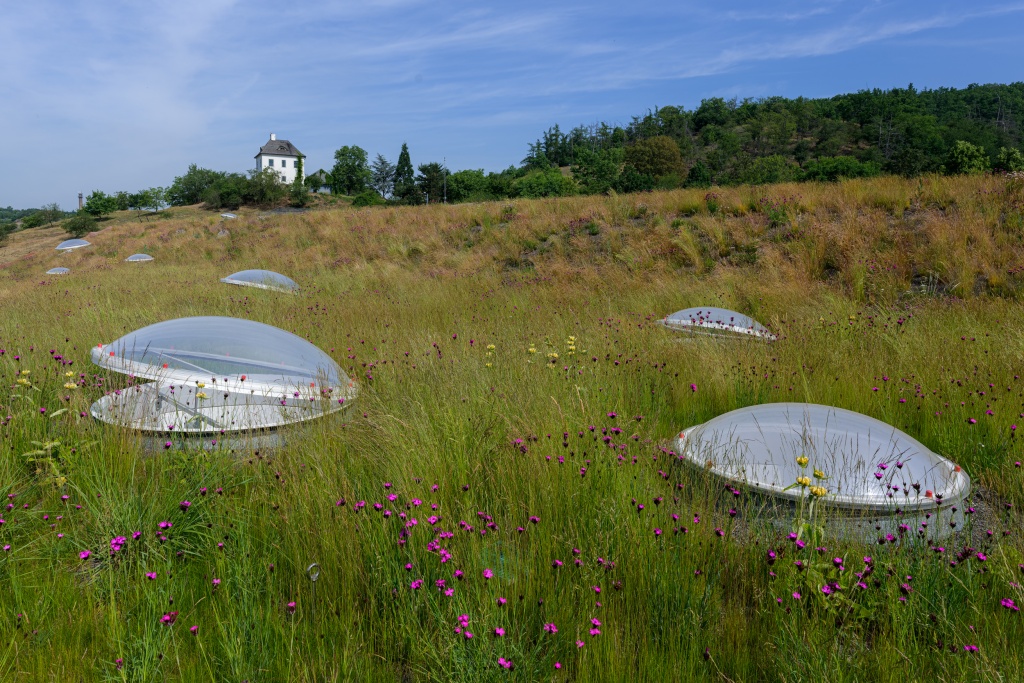
The pavilion’s green roof, planted with native vegetation, received the Green Roof of the Year 2023 award. In the background, you can see the Sklenářka building, which lent its name to the zoo’s entrance by the Dja Reserve. Photo: Petr Hamerník, Prague Zoo
It was not possible to use indigenous plants from the African rainforest in the outdoor plantings, as it was in the interiors with their temperature-controlled environment. Even so, we managed to select a few plants from the cooler mountains of Africa. Of the perennials, the exotic-looking succulent rosettes of the genus Kniphofia (commonly known as torch lilies or red hot pokers), with their fiery, torch-like flowers in shades of yellow, orange, or red, are particularly striking. Another intriguing plant is the subshrub Phygelius, also known as Cape fuchsia, which bears eye-catching, trumpet-shaped flowers adapted to be pollinated by sunbirds. African feather grass (Pennisetum macrourum) with its distinctive, bristly flower panicles and surprising growth of up to 1.5 m accompanies visitors throughout the exhibit from the roof of the pavilion all the way to the giraffe enclosure.

Torch lily—one of the African plants growing in the outdoor areas of the Dja Reserve. Photo: Petr Hamerník, Prague Zoo
Although the other plants are not native to Africa, at least their exotic appearance imitates the atmosphere of the gorillas’ home habitat. The Kentucky coffee trees (Gymnocladus dioicus) located right in the gorilla enclosure offer spectacular pinnate leaves growing to more than half a metre in length. Mature specimens weighing several tonnes, imported from Germany, were planted by crane and became the largest trees to be planted in Prague Zoo.
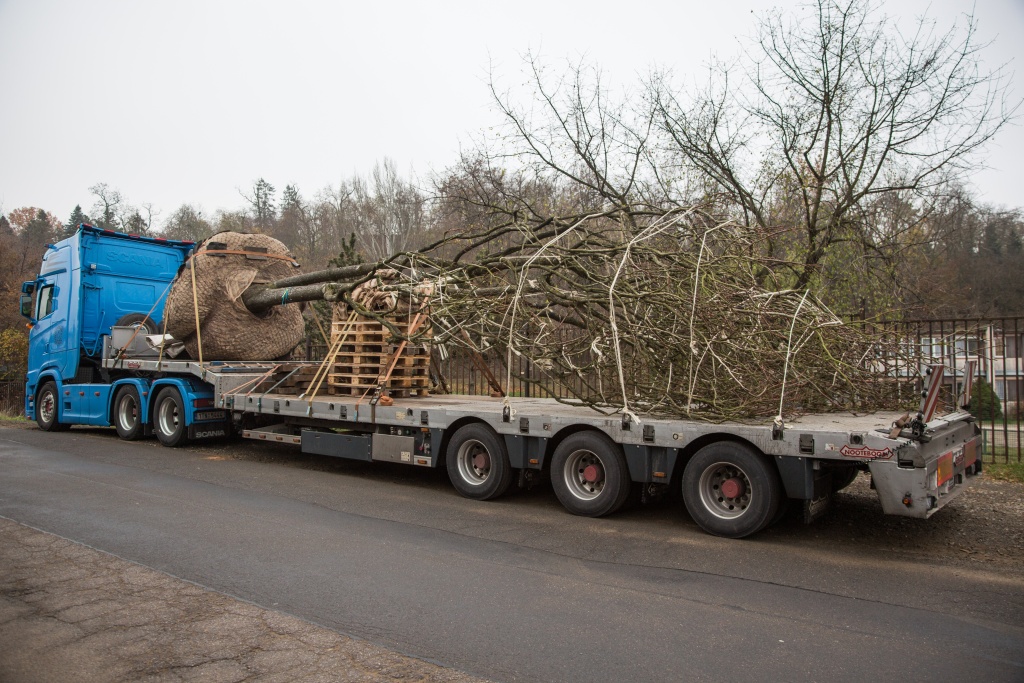
The several-tonne Kentucky coffee trees being transported to the zoo. Photo: Tereza Mrhálková, Prague Zoo
In the immediate vicinity of the enclosure, the princess tree (Paulownia tomentosa) spreads its giant leaves in a continuous heart-shaped area. Its reddish hairy flower buds present in wide-branched panicles throughout the winter also look exotic. These develop into magnificent trumpet-like purple flowers in early spring before the leaves emerge.
Evergreens such as the southern magnolia (Magnolia grandiflora) and spotted laurel (Aucuba japonica) mimic the freshness of the rainforest even during winter. Bamboos of many species form an essential evergreen backdrop. Phyllostachys predominates with its typical solid, yellow-green stems that grow several metres high. Meanwhile, running bamboos of the genus Sasa create an undergrowth layer in many parts of Prague’s Dja Reserve. Bamboos are also among the plants that gorillas encounter in the undergrowth of tropical forests.
Vines complete the picture of lush forest growth not only inside the pavilion, but also outside. The pavilion’s walls are adorned with large-leaved climbers such as Ductchman’s pipe (Aristolochia macrophylla) and Chinese trumpet vine (Campsis grandiflora) with its large, red, trumpet-shaped flowers.

One of the most distinctive features of the giant rhubarb is its enormous leaves. Photo: Petr Hamerník, Prague Zoo
Throughout the outdoor spaces, visitors are surrounded by lush “rainforest” vegetation at all layers of the plant community. The final layer, which is the most species-rich, consists of herbaceous perennials—plants that do not develop woody above-ground parts. One of the most exotic is the giant rhubarb (Gunnera tinctoria), with leaves over a square metre in size, and harmless spines lining their undersides. This species is native to the wetlands of Chile in South America and is very sensitive to central European winters. Although it can be invasive and spread uncontrollably across the landscape in many countries with warmer climates, our gardeners are kept very busy with the challenge of protecting it from the cold throughout the winter.
ZOOPRAHA.CZ
Contacts
- The Prague zoological garden
U Trojskeho zamku 120/3
171 00 Praha 7
Phone.: (+420) 296 112 230 (public relations department)
e-mail: zoopraha@zoopraha.cz
Others










